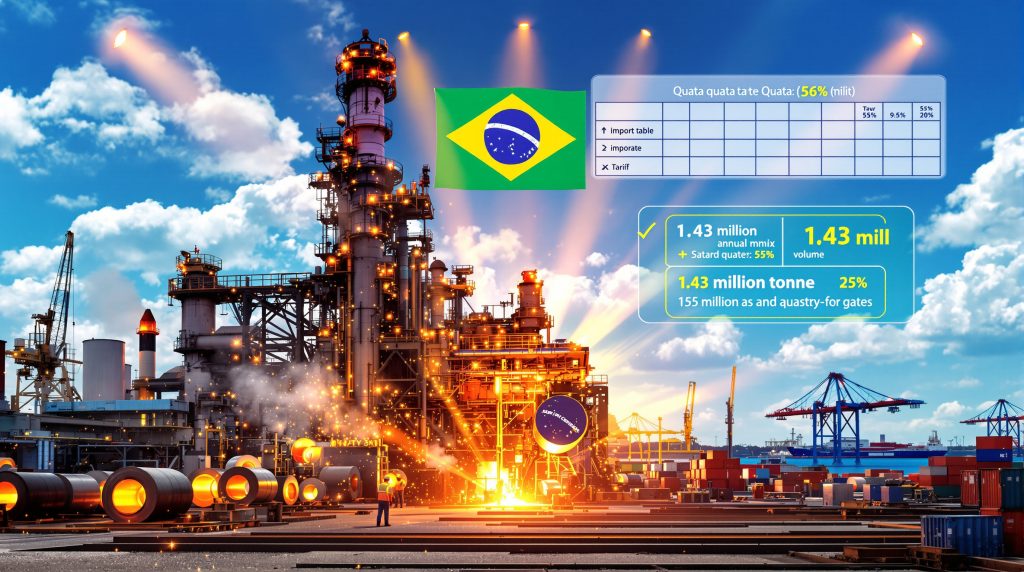Understanding Brazil Steel Import Safeguards and Their Global Context
Brazil's steel import protection framework has emerged as a critical component of South American trade policy, representing one of the region's most sophisticated defense mechanisms against unfair international competition. These Brazil steel import safeguards have undergone significant evolution as global steel markets experience unprecedented disruption and excess capacity seeks new outlets.
The system operates through a complex two-tier structure combining reduced-tariff quotas with substantial penalty duties for volumes exceeding established thresholds. This approach reflects Brazil's attempt to balance domestic industry protection with the needs of steel-consuming sectors that rely on competitively priced inputs.
The Architecture of Brazil's Tariff-Quota Protection System
Brazil's steel import control mechanism centers on a sophisticated tariff-rate quota system administered by the Secretariat of Foreign Trade (SECEX). Under this framework, approximately 1.43 million tonnes of steel products annually qualify for preferential tariff rates ranging from 9% to 16%, while imports exceeding these carefully calibrated thresholds face a substantial 25% safeguard duty.
The current system encompasses 23 distinct steel product categories, representing a notable expansion from the original 19 products when the framework first launched. This growth pattern demonstrates Brazil's responsive approach to addressing trade circumvention tactics, where importers historically shifted purchasing patterns to unprotected product lines to avoid higher duty assessments.
Recent regulatory developments have introduced annual quota reductions of approximately 250,000 tonnes across 13 product categories, creating a more restrictive environment for steel imports. The system employs monthly monitoring mechanisms that automatically trigger penalty tariffs when quota utilization reaches predetermined levels.
How Brazil's Steel Import Quota Allocation Functions in Practice
The operational mechanics of Brazil steel import safeguards reveal a sophisticated administrative system designed to manage trade flows while maintaining market access for legitimate commercial activity. Import licenses are distributed through a combination of historical volume assessments and first-come, first-served allocation principles within designated quota periods.
By mid-2025, importers had utilized approximately 56% of available reduced-tariff quotas, with coated steel products accounting for nearly 500,000 tonnes of this allocation. This utilization pattern indicates sustained import demand despite the existence of protective measures, suggesting that current quota levels remain sufficient to accommodate significant commercial activity.
Special Treatment Provisions and Exemptions
The safeguard framework incorporates various exemption mechanisms that reflect Brazil's broader trade policy objectives:
• Mercosur trade agreement partners receive preferential treatment under regional integration commitments
• Special economic zones such as the Manaus Free Trade Zone operate under modified provisions due to constitutional protections
• Historical importers may receive allocation preferences based on established trading relationships
• Monthly quota adjustments allow for flexible response to changing market conditions
These provisions create a multi-layered system that attempts to balance protection with international trade obligations and domestic economic development priorities.
Measuring the Impact of Steel Import Safeguards on Brazilian Markets
Despite increasingly robust protection measures, steel imports into Brazil have demonstrated remarkable persistence, creating complex market dynamics that challenge traditional assumptions about safeguard effectiveness. Import volumes grew 18.6% in 2024 and surged an additional 27.5% year-over-year through early 2025, indicating that current measures have not substantially deterred international suppliers.
However, recent data reveals a significant reversal in these trends, with imports declining 24% year-over-year by August 2025. This shift reflects multiple interconnected factors beyond safeguard policy effectiveness:
Economic Factors:
- Weakened domestic construction demand reducing steel consumption
- High Brazilian interest rates dampening manufacturing activity
- Infrastructure project delays affecting procurement schedules
- Currency fluctuations influencing import competitiveness
Regulatory Changes:
- Enhanced anti-dumping duty coverage across major product categories
- Stricter quota monitoring and enforcement procedures
- New product classification requirements increasing compliance costs
Regional Market Segmentation and Import Dependencies
Brazil's extensive geography creates distinct regional markets with varying degrees of import reliance. Northern and northeastern states maintain higher dependency on imported steel due to logistical constraints and distance from major domestic production facilities concentrated in the southeast.
This geographical factor complicates the effectiveness of national-level safeguard policies, as regional markets may respond differently to the same protective measures. Data from the Brazilian Steel Association indicates that imports currently represent approximately 25% of domestic steel consumption, with domestic producers maintaining roughly 75% market share.
However, this national average masks significant regional variations that influence local pricing and supply chain dynamics.
Why Brazilian Producers Continue Demanding Enhanced Protection
Major Brazilian steel companies, including industry leaders Gerdau, CSN, Usiminas, and ArcelorMittal Brasil, maintain that current Brazil steel import safeguards remain insufficient to address the scale of global trade distortions affecting the sector. Their advocacy for stronger measures centers on several interconnected concerns about market integrity and long-term industrial sustainability.
According to statements from industry executives, Brazil has become a primary destination for steel exports that cannot access traditional markets due to enhanced trade barriers. Luis Fernando Martinez, Executive Director and Board Member of Companhia Siderúrgica Nacional (CSN), characterized the situation by noting that "Brazil represents the primary available market for Chinese steel exports seeking alternative destinations."
Circumvention Challenges and Enforcement Limitations
Brazilian producers identify multiple mechanisms through which current safeguards are being circumvented:
Product Classification Manipulation:
- Slight modifications to steel products to avoid covered categories
- Strategic blending of materials to alter tariff classifications
- Documentation practices that obscure true product specifications
- Technical specification adjustments that maintain functionality while avoiding duties
Trade Route Diversification:
- Transshipment through third countries to obscure origin
- Processing in intermediate locations to establish alternative country of origin
- Strategic timing of shipments to maximize quota utilization
- Coordination among exporters to optimize market access
Below-Cost Pricing Strategies:
- Export pricing that appears to disregard production costs
- Government subsidies enabling artificially competitive pricing
- Strategic dumping to establish market share before protection measures take effect
- Coordinated pricing among major exporting nations
The Brazilian Steel Association characterizes this pattern by stating that "Brazil is becoming the preferred destination for steel sold below cost, as other major markets implement increasingly restrictive trade defense measures."
Global Trade Tensions and Their Effects on Brazilian Steel Policy
The interconnected nature of global steel markets means that trade policy decisions in major economies create cascading effects that directly influence Brazil steel import safeguards policy development. Furthermore, recent developments in both the United States and European Union have intensified pressure on Brazilian policymakers to strengthen domestic protection measures.
The ongoing US-China trade war has created significant disruptions in global steel flows, with diverted production seeking alternative markets. This situation demonstrates how trade war supply chains can create unintended consequences for countries like Brazil.
US Section 232 Tariff Impact Analysis
The United States currently maintains Section 232 national security tariffs on Brazilian steel at 50% for most product categories, representing a significant escalation from previous trade relationships. Under the current Trump administration, these tariffs reflect a broader policy approach emphasising domestic industrial protection through aggressive trade measures.
Despite these substantial tariff barriers, the impact on Brazilian export volumes to the US has been less dramatic than initially anticipated. The broader implications of how tariffs impact markets have been particularly evident in the steel sector's adaptability.
Brazilian producers have demonstrated remarkable adaptability through several strategic adjustments:
Market Diversification Strategies:
- Increased exports to European Union markets, particularly Italy
- Development of alternative supply relationships in Latin America
- Enhanced focus on higher-value specialty steel products
- Strategic pricing adjustments to maintain competitiveness in available markets
Operational Adaptations:
- Price reductions of approximately $10 per tonne for alternative markets to increase market penetration
- Supply chain modifications to serve geographically diverse customers
- Product portfolio adjustments to match demand in accessible markets
- Enhanced customer relationship management in non-restricted territories
European Union Safeguard Reforms and Policy Alignment
The European Commission's October 2025 proposal for steel import safeguard reforms represents a significant escalation in global trade protection measures. The proposed framework includes a 47% reduction in tariff-free quotas combined with 50% ad valorem duties on volumes exceeding revised thresholds.
Brazilian industry associations view these developments as validation of their requests for enhanced domestic protection. The Brazilian Steel Association characterised the EU proposal as representing "yet another major global steel player implementing tough measures to preserve domestic mills' ability to invest and generate employment."
This international trend toward enhanced protection creates several implications for Brazilian policy development:
| Region | Protection Mechanism | Key Features | Impact on Brazil |
|---|---|---|---|
| United States | Section 232 Tariffs | 25-50% flat rates | Export diversion to other markets |
| European Union | Quota + Ad Valorem | 47% quota cuts, 50% penalty duties | Reduced export opportunities |
| Canada | Selective Safeguards | Variable product coverage | Limited direct impact |
| Brazil | Tariff-Rate Quotas | 25% above-quota penalty | Growing pressure for enhancement |
Economic Arguments Surrounding Steel Import Protection
The debate over Brazil steel import safeguards effectiveness reflects broader economic tensions between industrial protection and consumer welfare. Different stakeholder groups present compelling arguments based on their respective market positions and economic interests.
Producer Investment and Employment Perspectives
Brazilian steel producers argue that effective safeguards serve as essential prerequisites for maintaining domestic industrial capacity and employment levels. They contend that without adequate protection from subsidised or below-cost imports, the domestic industry cannot sustain the investment levels necessary for technological advancement and competitive production.
Investment Protection Indicators:
- Production facility utilisation rates averaging approximately 75% of capacity
- Capital expenditure commitments requiring predictable market conditions
- Employment levels in steel-producing regions dependent on industry stability
- Downstream industry supply security requiring domestic production capability
Industry executives emphasise that "the quota system regulating steel entry into the domestic market requires strengthening to provide the predictable business environment necessary for long-term investment planning."
Steel Consumer Industry Concerns
Industries dependent on steel inputs, including construction, automotive, and machinery manufacturing, express concerns about potential cost increases resulting from enhanced import restrictions. These sectors historically benefited from access to competitively priced international steel supplies that helped maintain their own competitiveness in global markets.
However, market participants who have traditionally relied on imports acknowledge the complexity of the current situation. Industry sources indicate concerns that the diversion of low-priced production to Brazil may trigger additional anti-dumping measures, potentially creating less predictable supply conditions than more balanced trade flows would provide.
Consumer Industry Considerations:
- Input cost management requiring access to competitively priced steel
- Supply chain reliability needing diverse sourcing options
- International competitiveness dependent on cost-effective inputs
- Long-term supply security requiring sustainable domestic production
International Comparison of Steel Protection Frameworks
Brazil steel import safeguards operate within a global context where major steel-consuming economies have implemented increasingly sophisticated protection mechanisms. Understanding these comparative frameworks provides insight into alternative approaches and potential policy evolution paths.
The effects of global metal tariff effects have been particularly pronounced in commodities markets, while the specific iron ore market impact demonstrates how protective measures cascade through related industries.
Global Protection Mechanism Analysis
The proliferation of steel protection measures across major markets reflects widespread concerns about overcapacity and unfair trading practices. Different approaches demonstrate varying philosophical orientations toward balancing protection with market access:
United States Approach:
- Broad-based Section 232 national security tariffs
- Flat-rate structure of 25-50% across most steel categories
- Limited product exemptions or quota provisions
- Emphasis on domestic supply chain security
European Union Framework:
- Sophisticated quota management system with regular reviews
- Proposed 47% quota reductions with 50% penalty duties
- Product-specific allocation based on historical patterns
- Balance between protection and trade agreement obligations
Brazilian System:
- Tariff-rate quota structure with 25% above-quota penalties
- 23 product categories with differentiated treatment
- Responsive expansion to address circumvention
- Integration with anti-dumping duty frameworks
Canadian Measures:
- Selective safeguard application based on injury determinations
- Product-specific assessment through tribunal processes
- Limited scope compared to comprehensive systems
- Focus on specific threat mitigation
Emerging Patterns in Global Steel Trade Governance
The convergence toward enhanced steel protection across multiple jurisdictions suggests fundamental shifts in global trade policy philosophy. Traditional approaches emphasising market liberalisation are being reconsidered in light of persistent overcapacity and state-sponsored competition distortions.
Several common themes emerge across different national approaches:
• Increased focus on domestic industrial capacity as national security priority
• Recognition of market distortions requiring government intervention beyond traditional anti-dumping measures
• Adaptive policy frameworks designed to respond to circumvention and changing trade patterns
• Balance between protection and international obligations through sophisticated quota and exemption systems
Future Trajectories for Brazilian Steel Import Policy
The evolution of Brazil steel import safeguards will likely reflect broader transformations in global trade governance and industrial policy approaches. Several factors will influence policy development over the coming years.
Market Dynamics and Technological Factors
Recent data indicating a 30% increase in flat steel product imports through August 2025, with projections suggesting a 32.2% full-year increase, demonstrates the persistent challenge facing Brazilian policymakers. This growth rate represents nearly three times the historical average, indicating fundamental shifts in global trade patterns rather than cyclical fluctuations.
Chinese regulatory changes affecting export pricing mechanisms will continue influencing global steel flows. As Chinese domestic policies evolve, their impact on international markets will require adaptive responses from importing countries including Brazil.
Technology and Enforcement Innovation:
- Digital tracking systems for improved quota monitoring
- Advanced data analytics for circumvention detection
- Automated quota management reducing administrative burden
- Real-time market monitoring enabling responsive policy adjustments
Regulatory and Policy Development Trends
The Brazilian government faces increasing pressure to align its trade defence capabilities with international standards while maintaining compliance with World Trade Organization obligations. Future policy development will likely incorporate lessons learned from other major markets' experiences with steel protection.
Anticipated Policy Evolution Areas:
- Enhanced product coverage addressing circumvention gaps
- Improved enforcement mechanisms with stronger penalties
- Integration with broader industrial policy objectives
- Coordination with regional trade partners on common approaches
International Coordination Considerations:
- WTO compliance requirements for safeguard measure implementation
- Regional trade agreement obligations within Mercosur framework
- Bilateral trade relationship management with major partners
- Participation in global forums addressing steel overcapacity
Strategic Implications and Industry Outlook
Brazil steel import safeguards represent a sophisticated attempt to navigate the complex intersection of domestic industrial policy, international trade obligations, and economic development objectives. The ongoing evolution of this framework reflects broader challenges facing medium-sized economies seeking to protect strategic industries while maintaining integration with global markets.
The success of these measures will ultimately depend on their ability to provide meaningful protection for domestic producers while ensuring reasonable access to steel inputs for downstream industries. As global trade tensions continue reshaping steel markets worldwide, Brazil's experience offers valuable insights into the practical challenges of implementing effective trade defence measures.
Critical Success Factors for Future Development
Several key elements will determine the long-term effectiveness of Brazilian steel import protection:
Policy Framework Adaptability:
- Responsive mechanisms addressing new forms of circumvention
- Regular review processes incorporating market feedback
- Flexibility to adjust protection levels based on changing conditions
- Integration with broader economic development strategies
Stakeholder Balance:
- Meaningful consultation with both producers and consumers
- Transparent decision-making processes building public support
- Recognition of regional variations in market conditions
- Coordination with related policy areas affecting competitiveness
International Relationships:
- Maintenance of constructive trade relationships with major partners
- Compliance with multilateral trade system obligations
- Participation in international efforts addressing root causes of trade distortions
- Leadership in developing effective governance mechanisms for global steel markets
The trajectory of Brazil's steel import safeguards will continue reflecting broader themes in international trade policy, including tensions between globalisation and industrial sovereignty, the appropriate role of government in market protection, and challenges of maintaining competitiveness in an increasingly complex global economy.
For more detailed insights on Brazil's safeguard measures, industry stakeholders can access comprehensive analysis from trade defence specialists. Additionally, recent developments regarding the expansion of these measures provide current context for understanding policy trajectories.
Disclaimer: This analysis is based on publicly available information and industry statements as of October 2025. Steel trade policies are subject to frequent changes, and stakeholders should consult official government sources for the most current regulations and requirements. Market projections and policy predictions involve inherent uncertainties and should be considered alongside other relevant factors when making business or investment decisions.
Looking to Capitalise on Commodity Market Volatility?
Discovery Alert's proprietary Discovery IQ model delivers real-time notifications about significant ASX mineral discoveries, helping investors identify trading opportunities before the broader market responds to changing global conditions. With steel markets experiencing major disruptions and mining companies potentially benefiting from shifting trade dynamics, subscribers gain immediate insights into actionable opportunities across more than 30 commodities. Begin your 30-day free trial today to position yourself ahead of market movements.




